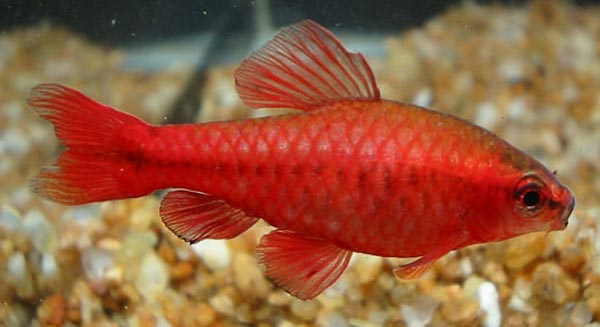The Cherry Barb originates from the shaded streams and rivers on the plains of Sri Lanka. Most of the species are attractive and peaceful aquarium fish. They also have the further attraction of being hardy and easily bred. They are not touchy where food is concerned as long as they receive lots of it.

It has been advised that you condition the pair before you are ready to breed them. For breeding, I used a small three gallon tank. The bottom was bare, except for a fine plastic mesh. This covered the bottom in case some eggs should fall, so could be saved before the parents ate them. It also gave the small fry a place to hide. The water was a mixture of hard and soft tap water. The temperature was set for around 76 degrees F. I wasn’t concerned about pH, occasionally I added a few drops of black water extract when doing a water change. The tank consisted of a sponge fry filter, Java moss and sufficient room for swimming. Then I added a male and female cherry barb. I watched and watched. Months went by. I could see no eggs or fry. The female became plump and the male was a beautiful cherry red colour. Time went by and still I couldn’t see any fry or eggs. Back in the community tank they went, enough was enough, I must have missed something!
Months later I decided to try again and I followed the same procedure. They were put into the tank at night as I had read somewhere that the next morning the pair will be dashing around in a lively manner. The female will stop in a plant thicket and allow the male to cosy up beside her as she expels 3-4 eggs onto the plant. The male immediately fertilises them. The chase resumes and this procedure is repeated again and again. Up to 300 eggs could be laid. The eggs stick to what ever surface they touch and some may fall to the bottom of the tank. Soon the fish lose interest in each other and they must be removed before they devour the eggs. The eggs will hatch in 48 hours and the fry will hang helplessly from what ever it was they stuck too. When their egg sacks are absorbed, in about three or four days, they will begin to free swim. Young fry have very healthy appetites and should be well fed.
Why don’t things go that smoothly in real life? On my second try to breed these fish still nothing was happening. No eggs and no fry could be seen. I looked and waited. One morning I decided to give up and clean out the tank. The fish were removed, and feeling defeated I began siphoning out the debris piled up in the tank. Just by chance I looked into the messy pail of water that I was ready to throw out and to my surprise I could barely see a few very very small colourless fry on the bottom of the pail. Oh! I gasped, there’s babies in here and I could have thrown them out. Immediately I set up a small clean tank with 48 hour old clean water. The same temperature was maintained by warming the water in the microwave. I siphoned as many fry as I could see and then went to the original tank and lifted the mesh from the bottom of the tank. There were more fry hiding there so I continued to siphon out everything that moved. The next day I could count only three fry free swimming. A few days later there were nine or ten, and after two weeks I counted forty-seven fry. They have now been moved into a 10 gallon tank and are thriving. I feed them live brine shrimp and dry sifted fry food twice a day.
I have learned more than one lesson from this experience. Don’t be in a rush and always very carefully check the water you are going to throw down the drain, there could be some fry in there. Maybe I’ve done this before, but I sure won’t again!
Leave a Reply